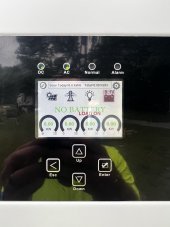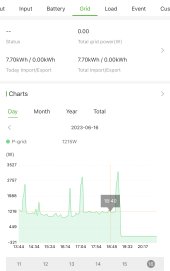jarred125
New Member
- Joined
- Jul 16, 2021
- Messages
- 103
Edit: The title is misleading, I am sorry (it has been a LONG day). I currently have power but it seems to be in bypass mode only. This happened after changing the mentioned setting to "no battery" which then killed the output to the loads entirely. Power cycling it does nothing, it just sits at "OFF" on the display after that. Unchecking the "no battery" setting brings us back online but without any data on the LCD screen and no data recorded in the app (no voltage, amps, etc).
I posted this to the general area because my brain was not braining, it belongs here.
I finally have my system up, sort of.
Following the Solark 30 minute video they indicate to check the “no battery” option if you, indeed, have no battery. We are grid tied, and when checking that setting the system won’t power any loads from the grid or PV. Disabling that setting brings power back but it is apparently in bypass mode (normal LED is off).
Attached is my current view of the LCD. Any help is appreciated, Solark is currently closed so no support at the moment.
I am seeing PV at the terminals (no info on the LCD or in the app), 280ish on MPPT1 and 2, 240ish on MPPT3. This is expected as the third has 6 panels rather than the first two having 7.
For more information about my setup:
Grid goes to a 200A fused disconnect, from there to the SolArk Grid input, load L1/L2 out to the main panel. PV input comes from three strings of panels, 7, 7 and 6 (Canadian solar 445W). They run into two IMO 4 pole DC disconnects, then to the inverter. The run back to the house is 10 AWG THWN-2, 6 conductors total.
I posted this to the general area because my brain was not braining, it belongs here.
I finally have my system up, sort of.
Following the Solark 30 minute video they indicate to check the “no battery” option if you, indeed, have no battery. We are grid tied, and when checking that setting the system won’t power any loads from the grid or PV. Disabling that setting brings power back but it is apparently in bypass mode (normal LED is off).
Attached is my current view of the LCD. Any help is appreciated, Solark is currently closed so no support at the moment.
I am seeing PV at the terminals (no info on the LCD or in the app), 280ish on MPPT1 and 2, 240ish on MPPT3. This is expected as the third has 6 panels rather than the first two having 7.
For more information about my setup:
Grid goes to a 200A fused disconnect, from there to the SolArk Grid input, load L1/L2 out to the main panel. PV input comes from three strings of panels, 7, 7 and 6 (Canadian solar 445W). They run into two IMO 4 pole DC disconnects, then to the inverter. The run back to the house is 10 AWG THWN-2, 6 conductors total.
Attachments
Last edited:




